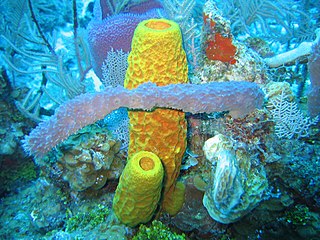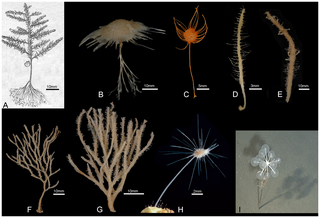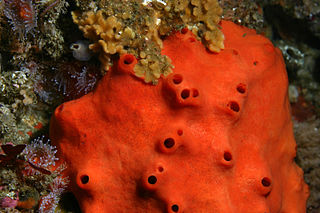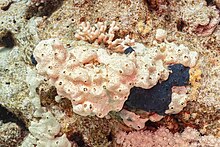
Demosponges (Demospongiae) are the most diverse class in the phylum Porifera. They include greater than 90% of all species of sponges with nearly 8,800 species worldwide. They are sponges with a soft body that covers a hard, often massive skeleton made of calcium carbonate, either aragonite or calcite. They are predominantly leuconoid in structure. Their "skeletons" are made of spicules consisting of fibers of the protein spongin, the mineral silica, or both. Where spicules of silica are present, they have a different shape from those in the otherwise similar glass sponges. Some species, in particular from the Antarctic, obtain the silica for spicule building from the ingestion of siliceous diatoms.

Siphonostomatoida is an order of copepods, containing around 75% of all the copepods that parasitise fishes. Their success has been linked to their possession of siphon-like mandibles and of a "frontal filament" to aid attachment to their hosts. Most are marine, but a few live in fresh water. There are 40 recognised families:

Halichondriidae is a family of sea sponges belonging to the order Suberitida. These sponges have a skeleton consisting of dense bundles of spicules occurring in a more or less random pattern.

Cidaridae is a family of sea urchins in the order Cidaroida.

Cliona is a genus of demosponges in the family Clionaidae. It contains about eighty described species.
Isodictya is a genus of marine demosponge in the family Isodictyidae.
Myxillidae is a family of marine demosponges.

Mycalidae is a family of marine demosponges.
Homaxinella is a genus of sea sponges in the family Suberitidae. The type species is Homaxinella balfourensis.

Cladorhizidae is a family of carnivorous demosponges found in deep-sea environments worldwide. These sponges are known for their unique feeding structures and predatory behavior, as they capture and consume small animals such as crustaceans.
Calthropella is a genus of sea sponges in the order Tetractinellida. It is the only genus in the monotypic family Calthropellidae.

Farrea is a genus of glass sponges in the family Farreidae.

Acarnidae is a family of sponges belonging to the order Poecilosclerida. It has a global distribution, although several genera occur primarily in colder temperate waters, and several have very restricted ranges. It is estimated that there are several hundred species.

Iophon is a genus of sponges belonging to the family Acarnidae. The genus has a cosmopolitan distribution.

Coelosphaeridae is a family of sponges belonging to the order Poecilosclerida. Species are found across the globe.

Acarnus is a genus of sponges belonging to the family Acarnidae. The genus has almost cosmopolitan distribution.

Raspailiidae is a family of sponges belonging to the order Axinellida.
Hamacantha is a genus of sponges in the family Hamacanthidae. This species in this genus differ from those in the other genera in this family through the presence of diancistras, distinctive microscleres. These are thought to aid in framing the skeleton by joining monactine megascleres. This genus contains 30 species in three subgenera.
Tetilla is a genus of demosponges in the family Tetillidae. It is widely distributed. They are mainly found in deeper habitats.
Cladocroce is a genus of demosponges in the family Chalinidae.













